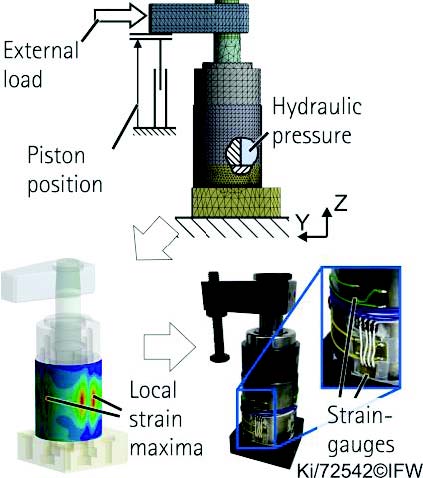Monitoring of system and process state by application of sensory clamping elements
The investigation of a sensory clamping system for industrial practice is the aim of the transfer project T02. Therefore, prototypical elements for a hydraulic clamping system, which is typically used in series production, are being developed. In close cooperation with both industrial partners Roemheld GmbH and ReiKam GmbH a sensory clamping system for a real application scenario is being developed, prototypically realized and analyzed. In addition to the acquisition of process state, the state of the clamping system itself needs monitoring. Error conditions such as wear, overload, incorrect setting and improper use get automatically detected. Besides the sensor integration, high system robustness, the power and data transfer to rotating systems and the consideration of cost aspects are special requirements for the system.
A clamping device, see Figure 1, from the portfolio of the company ReiKam was chosen as the application scenario. In order to fix the part in the work area three hydraulic swing clamps and one hydraulic support of the company Roemheld are used, which are being provided with sensors.



Here, strain gauges and temperature sensors are selected for the integration into the clamping elements. The analog signal paths are kept as short as possible to reduce interferences to the signals. Therefore, each sensory clamping element is connected to an electronic board in close proximity, which is used for signal preprocessing and digitalization. A CANBus interface on each measuring electronic device allows the flexible extension of the clamping system by additional sensory elements.
To supply the measuring electronics with electric power and the clamping elements with hydraulic energy, the development of a hybrid interface for a rotating system is an important part of the project. The electric power transmission will be performed contactless via inductive coupling. The integration of the induction coils and the electrical circuits into the hydraulic rotary joint is being designed in cooperation with the company Roemheld. The partner has longstanding expertise in manufacturing hydraulic rotary joints.
Based on FEM analyses, see Figure 2, clamping elements were equipped with strain gauges. These sensing swing clamps are able to measure the hydraulic pressure, external forces and different piston positions and pave the way for a digitalized manufacturing in terms of Industrie 4.0. To validate the complete system several sensory clamping elements are being assembled to a clamping system, see set-up in Figure 3, to be exposed to industrial conditions by practical cutting trials.






Subproject leader


30823 Garbsen


Industry partner
Römheldstraße 1-5
35321 Laubach
Römheldstraße 1-5
35321 Laubach
71083 Herrenberg
71083 Herrenberg


